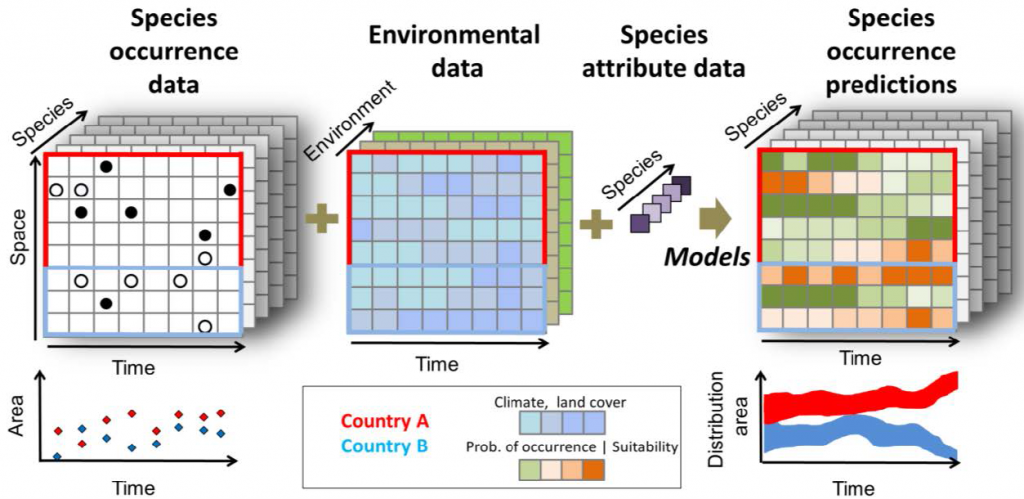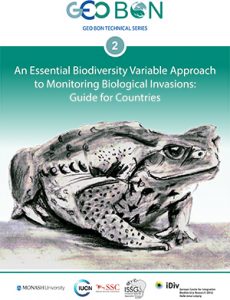The dynamics of species populations, i.e. the variation of species geographic distributions and abundances in space and time, represent one of the most fundamental aspects of biodiversity and its change. Decreases in the sizes of populations and contractions in the distribution of species result in the loss of potentially significant functions from communities and ecosystems, and in extreme cases may cause their global extinction. Conversely, expanding or shifting populations translate in the perturbation of existing or invasion of new communities, both with multifold consequences for ecosystems. Changes in the occurrence or abundance of species are thus key drivers of changes in ecosystem function and services. When related to information on patterns of environmental change, spatiotemporal data on species populations can inform about the putative causes of biodiversity and ecosystem change. In the context of resource management and conservation, species population data supports spatially explicit planning, risk and threat analysis, and the assessment of management outcomes.
Definitions of Species Population EBVs
Species Distributions: The essential biodiversity variable for species distributions (SD EBV) is: “the probability of occurrence over contiguous spatial and temporal units addressing the global extent of a species group consisting of one to many members.” (Jetz, McGeoch, Guralnick et al. 2019).
Species Abundance: The essential biodiversity variable for species abundances (SA EBV) is: “the predicted count of individuals over contiguous spatial and temporal units”. (Jetz, McGeoch, Guralnick et al. 2019).
Together, the SD EBV and the SA EBV, and their spatial aggregates or combinations with species attributes represent the Species Populations EBV class (for further detail see , Jetz, McGeoch, Guralnick et al. 2019).

Co-Leads
 Walter Jetz Yale University |
 Melodie McGeoch Monash University |
| Interested to join? Click the Register button. |
Key objectives
- Advance concepts and methodology for a generalizable capture of the distributions and abundances of species in space and time from regional to global scales
- Advance the distribution and abundance data integration through the development of standards, models, and infrastructure.
- Document key data and knowledge gaps and develop mechanisms to support the community in mobilizing data to help close them
- Support the development of example applications of the species population EBV for policy and management across local to national and global scales
1. Methods, models, scales, uncertainty
| Leads | Bill Kunin, Cory Merow (tbc) | |||
| Team | Antoine Guisan, Yoni Gavish, Petr Keil, Aidin Niamir, Carsten Meyer, Manuela D’Amen, Jorge Ahumada, Melodie McGeoch | |||
| Development approach | Data Mobilization, Modelling | |||
| EBVs | Species Distribution, Population Abundance | |||
| Description | A first project area will develop key explorations regarding methodological aspects of the SD EBV and the goal of modelling best-possible realized species distributions. This group will engage closely with the more empirically focused projects and use their and other datasets to address the following example questions:
|
|||
| Timeline | 2017 | 2018 | 2019 | 2020 |
| Milestones and/or Deliverables | Workshop | Workshop | ||
| Resources | NASA AIST (informatics) grant awarded. | |||
| Link with other WG, BONs, TF | This activity will support the activities SP4. to SP7. (“SD EBV strategic applications”). | |||
2. Completing, visualizing, and communicating the SD EBV
| Leads | TBD | |||
| Team | Carsten Meyer, Ingolf Kuhn, Walter Jetz, Simon Ferrier, Rob Guralnick, Melodie McGeoch, Tatsuya Amano | |||
| Development approach | Data mobilization, Modelling | |||
| EBVs | Species Distribution | |||
| Description | This project will advance populations EBV capture in practice, with particular focus on the SD EBV, and develop software and workflows to integrate and communicate these variables. Including taxon experts and data partners across terrestrial, freshwater and marine realms, this project will
|
|||
| Timeline | 2017 | 2018 | 2019 | 2020 |
| Milestones and/or Deliverables | MS: Conceptualizing the SD EBV Submission summer 2017 | Workshop, Project: Conceptualizing the SP EBV. | Tools for BON in a Box inclusion | |
| Resources | ||||
| Link with other activities | Support from and/or collaboration with EBV Data Task Force, National, Regional and Thematic BONs. | |||
3. Example implementations and use cases
| Leads | TBD | |||
| Team | Eric Le Tortorec, Eugenie Regan, Chhaya Chaudhary, Mark Costello, Eren Turak, Sami Domisch, Dirk Schmeller, Haigen Xu, Walter Jetz | |||
| Development Approach | Data mobilization, Modelling, Application | |||
| EBVs | Species Distribution | |||
| Description | This project will develop example applications and uses cases of the SD and PA EBVs. While the efforts envisioned here will often address a specific question or hypotheses, the specific applications are not of the overarching nature as the strategic applications listed below (but some of them may well grow into that stature). The overarching goal of this project is to demonstrate the SD EBV for very specific cases (region-taxon combinations) that are driven by different questions or motivations and additionally vary in data availability, complexity, and realm. We have to date discussed the following examples or comparisons:
|
|||
| Timeline | 2017 | 2018 | 2019 | 2020 |
| Milestones and/or Deliverables | Workshop, Prototype implementations | 3-5 strong use cases completed; linked to BON in Box, national BONs | ||
| Resources | ||||
| Link with other activities | Support from and/or collaboration with Thematic BONs. | |||
4. Implementing essential variables for invasion monitoring
| Leads | Melodie McGeoch, John Wilson, Greg Ruiz | |||
| Team | Peter Bellingham, Quentin Groom, John Wilson, Diana Bowler, Livia Schaeffler, Daniel Kissling, Aidin Niamir, Marten Winter, Walter Jetz, Rob Guralnick, Eric Le Tortorec, Alex Hardisty, Kristen Williams, Donald Hobern, Rebecca Pirzl, Lee Belbin, Daniel Kissling, Miles Nicholls, Nick dos Remedios, Shyama Pagad, Piero Genovesi, Ingolf Kuhn, Maria Londono |
|||
| Development Approach | Data mobilization, Modelling, Application | |||
| EBVs | Species Distribution, Population Abundance | |||
| Description | This activity will include conceptual development, a focus on country BONs, workflows and infrastructure to support applications, and development of novel indicators for alien and invasive species. Its aims include
|
|||
| Timeline | 2017 | 2018 | 2019 | 2020 |
| Milestones and/or Deliverables | Workshop at CSIRO January 2017 BON Development Meeting in Stanford – March 2017 | Workshop, Dashboard prototype implementation. | Workshop, Publication BON in a Box outputs | |
| Resources | ||||
| Link with other activities | Activity SP5. GLoBIS B Project (European Commission Funded, Project Horizon 2020, Project Task 3.3) Support from and/or collaboration with National, Regional and Thematic BONs. | |||
5. Known-unknowns for alien and invasive species distributions
| Leads | Carsten Meyer, Gregory Ruiz | ||||||
| Team | Aidin Niamir, Melodie McGeoch, Quentin Groom, GBIF DFFU_IAS Task Group, Mark Costello, Marten Winter, Franz Essl, Tiffany Knight | ||||||
| Development Approach | Data mobilization, Modelling, Application | ||||||
| EBVs | Species Distribution | ||||||
| Description | This project will conduct a gap analysis to quantify the adequacy of occurrence data for alien and invasive species, with the purpose of establishing priorities to improve data quality and outputs for end users. Further chapters of the PhD thesis supporting this activity (e.g related to alien distribution modelling) will depend on skills and interests of the student. | ||||||
| Timeline | 2017 | 2018 | 2019 | 2020 | |||
| Milestones and/or Deliverables | Recruitment of the PhD student. | ||||||
| Resources | PhD grant funded through iDiv Flexpool. | ||||||
| Link with other activities | Activity SP4. | ||||||
6. Distribution and population changes in rare species
| Leads | Walter Jetz, Hjalmar Kuhl (TBC) | |||
| Team | Petr Keil, Jon Paul Rodriguez, Marta Jarzyna, Antoine Guisan, Mark Costello, Tatsuya Amano | |||
| Development Approach | Data mobilization, Modelling, Application | |||
| EBVs | Species Distribution, Population Abundance | |||
| Description | A key innovation envisioned for the remote-sensing supported SD EBV predictions is the cross- and fine-scale capture of potential changes in species distributions over relatively short, e.g. annual time scales. This provides an important complement to expert-based evaluations of changes in species threat status that are temporally more coarsely resolved. In this strategic application, we will target a suite of species worldwide that are of particular conservation interest, e.g. due to their rarity, and that offer data that are sufficient, if likely heterogeneous in scale and quality, to demonstrate the use of SD EBV approaches (methods, infrastructure, reporting) for model-based monitoring of focal species. We will strategically focus on species or species groups that have already rich data and/or a community of experts that engages as partners. This will generally include selected species of rare vertebrates, invertebrates and plants, and specifically existing databases and efforts such as the APES (addressing primates globally) or similar expert groups. This project will for select taxa and species implement integrative and cross-scale modelling procedures to provide fine-grain predictions of spatial distributions, population sizes and their changes. These predictions are aimed at directly informing conservation and threat assessments. | |||
| Timeline | 2017 | 2018 | 2019 | 2020 |
| Milestones and/or Deliverables | Workshop | Products | ||
| Resources | Proposal submitted to the NASA A.50 funding call | |||
| Link with other activities | Remote Sensing Task Force | |||
7. Predicting plant abundances and their dynamics
| Leads | Adam Wilson | |||
| Team | Cory Merow, Jasper Slingsby, Walter Jetz, John Silander | |||
| Development Approach | Data mobilization, Modelling | |||
| EBVs | Species Distribution, Population Abundance | |||
| Description | One specific project, focused on South Africa, will use data from this region to develop remote-sensing informed abundance EBVs for hundreds of species in the charismatic Proteaceae plant family using the new generalized joint attribute modelling framework. | |||
| Timeline | 2017 | 2018 | 2019 | 2020 |
| Milestones and/or Deliverables | ||||
| Resources | Proposal submitted to the NASA A.50 funding call | |||
| Link with other activities | ||||
8. Incentives for sharing species occurrence data
| Leads | Eugenie Regan, Donald Hobern (TBC) | |||
| Team | Carsten Meyer Dirk Schmeller, Haigen Xu, Gary Geller, Hannu Saarenmaa, Rob Guralnick, Mark Costello | |||
| Development Approach | Data Mobilization, Modelling | |||
| EBVs | Species Distribution, Population Abundance | |||
| Description | This project aims to explore and provide examples for the different benefits for data holders to share their data. The proposed plan is to write a paper on “Why share species occurrence data?”. | |||
| Timeline | 2017 | 2018 | 2019 | 2020 |
| Milestones and/or Deliverables | Scientific publication | |||
| Resources | ||||
| Link with other activities | EBV Data Task Force | |||
Walter Jetz, Melodie A. McGeoch, Robert Guralnick, Simon Ferrier, Jan Beck, Mark J. Costello, Miguel Fernandez, Gary N. Geller, Petr Keil, Cory Merow, Carsten Meyer, Frank E. Muller-Karger, Henrique M. Pereira, Eugenie C. Regan, Dirk S. Schmeller, Eren Turak (2019) Essential biodiversity variables for mapping and monitoring species populations. Nature Ecology and Evolution. Download as PDF | https://doi.org/10.1038/s41559-019-0826-1
Pagad S, P Genovesi, L Carnevali, D Schigel, and MA McGeoch. 2018. “Introducing the Global Register of Introduced and Invasive Species”. Scientific Data. 5. Download as PDF | doi.org/10.1038/sdata.2017.202
 |
GEO BON Technical Series No. 2An Essential Biodiversity Variable Approach to Monitoring Biological Invasions: Guide for Countries |
WG Species Populations is linked to the NASA project:
WG Species Populations is linked to the sDiv project:
Melodie McGeoch (Monash University) and Marten Winter (iDiv)
Theory and Workflows for Alien and Invasive Species Tracking
sTWIST W6.30, Synthesis Centre of iDiv, the German Centre for Integrative Biodiversity Research (www.idiv.de/sdiv)

